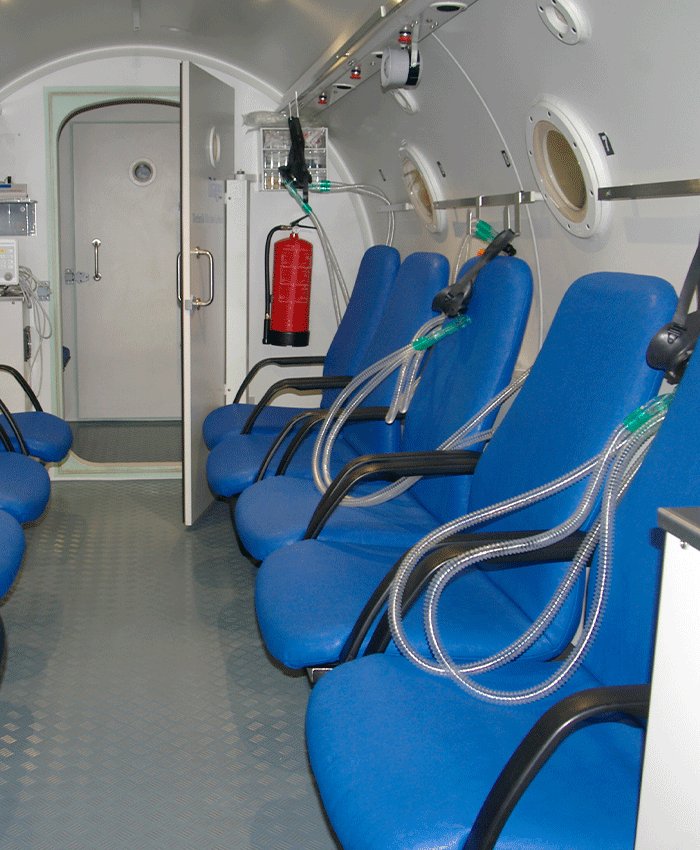Treatment
Hyperbaric Oxygen Therapy (HBOT)
Faster recovery (6x) due to freely available oxygen in tissue.
What is hyperbaric oxygen therapy?
Hyperbaric oxygen therapy (HBOT) is a non-invasive procedure in which clients find themselves breathing concentrated oxygen in a specially designed chamber at a higher atmospheric pressure (up to 1.5 ATA). The application is safe and can bring about health improvements in many areas.
The feeling experienced is similar to taking off/landing in a plane or swimming to the bottom of a pool. During treatment in the specially designed room, clients can comfortably watch Netflix or use their laptops or phones. It is possible that you share your experience with other participants.

Why is hyperbaric oxygen therapy important?
decompression sickness, or caisson’s disease in divers, dates back to early experimentation by British physician and minister Henshaw in 1662. Using bellows similar to those found in church organs, Henshaw pressurized his isolated chamber, known as the ‘domicilium.’
Today, modern hyperbaric chambers offer exceptionally high-quality compression capabilities with precise control over conditions. As a result, Hyperbaric Oxygen Therapy is experiencing a surge in popularity due to its demonstrated efficacy across various conditions.
Extensive scientific research supports its effectiveness in aiding recovery from inflammation, wound healing, circulatory problems, acute hearing loss, tinnitus, chronic pain, lung conditions like COVID-19, diabetic wound healing, and rehabilitation from brain injuries such as concussion or cerebral hemorrhage. Moreover, it has shown promise in rejuvenation through its effects on telomere lengthening.
The comprehensive body of research underscores the growing recognition of Hyperbaric Oxygen Therapy as a valuable medical intervention with diverse therapeutic applications.
How does hyperbaric oxygen therapy benefit patients?
Hyperbaric Oxygen Therapy offers the potential to expedite various therapeutic processes. For instance, recovery from concussion at 1.4 ATA has shown a remarkable acceleration of up to 600%. In elite athlete applications, HBOT facilitates quicker recovery from training, enabling more training sessions per week, enhancing sports performance, and expediting return to competition post-injury.
Moreover, HBOT promotes overall well-being and wellness by facilitating the abundant availability of oxygen in tissues, resulting in numerous positive effects on our sense of health and overall vitality.
How does hyperbaric oxygen therapy work?
Oxygen stands as the primary element crucial for cellular function, particularly within the central nervous system. This is due to the brain’s heightened requirement for oxygen to regulate various essential processes, including neuronal signal transduction, synaptic transmission, and nerve excitability associated with action potentials.
High-pressure oxygen therapy, such as HBOT, enables additional oxygen to dissolve in the blood plasma, supplementing the typically limited supply. By increasing the availability of free oxygen to cells, HBOT supports the potential for enhanced recovery and improved functionality, enabling cells to operate at a higher level of performance.

How does hyperbaric oxygen therapy help?
Hyperbaric Oxygen Therapy (HBOT) is known to enhance blood flow and stimulate the development of new blood vessels throughout the body, particularly in the brain. This increased cerebral blood flow is believed to boost neuronal function by encouraging axonal growth, thereby amplifying the communicative capacity of individual neurons and the overall neuronal network. Additionally, HBOT has been shown to promote neurogenesis and stimulate the growth of endogenous stem cells.
Moreover, HBOT serves as a potent inhibitor of reperfusion injury, a phenomenon that occurs when blood flow is restored to ischemic or oxygen-deprived tissues. This protective effect is particularly significant in cases of global ischemia, anoxia, and coma.
Further benefits of HBOT include its ability to reduce blood flow to damaged areas, mitigate inflammation without compromising oxygenation, signal DNA to induce trophic tissue changes, enhance the immune system’s ability to eliminate neutrophils, and promote collagen synthesis.
Given these fundamental effects, HBOT is thought to foster neuroplasticity and bolster immune function, even years after initial injury or insult.
What can you expect after treatment?
Following our intensive treatment week, patients can anticipate rapid results, ranging from quick to very quick. It’s common to feel tired during the initial few days or weeks post-treatment as the brain processes the heightened activity from the previous week.
However, thanks to its neuroplasticity, the brain is resilient and adept at adapting. Some individuals may experience mild irritability or occasional headaches during this adjustment period, but these are temporary and do not result in any permanent side effects.
Over time, these symptoms will diminish, and patients will begin to notice the increasingly positive effects of the therapy.

